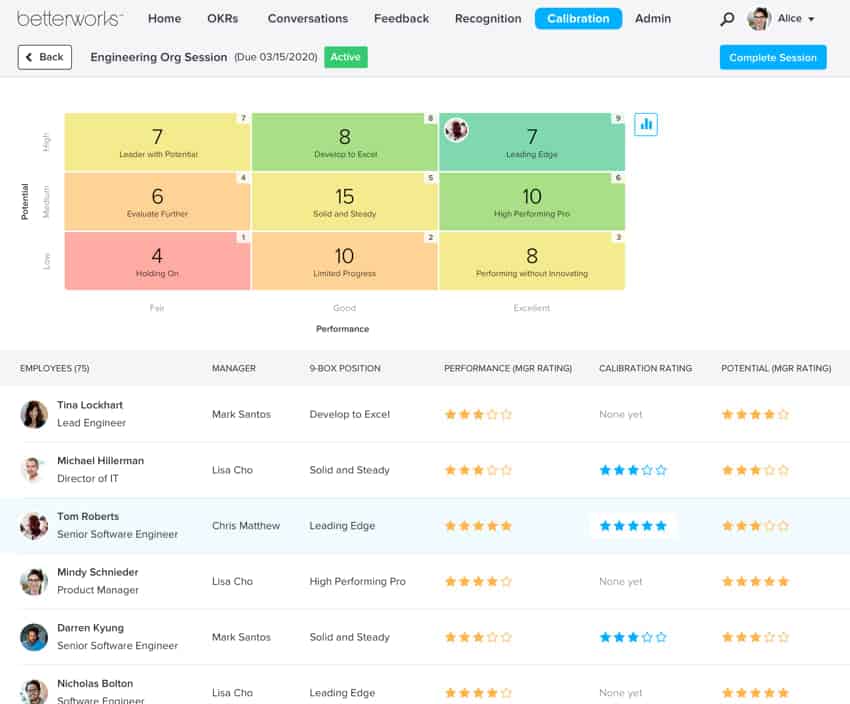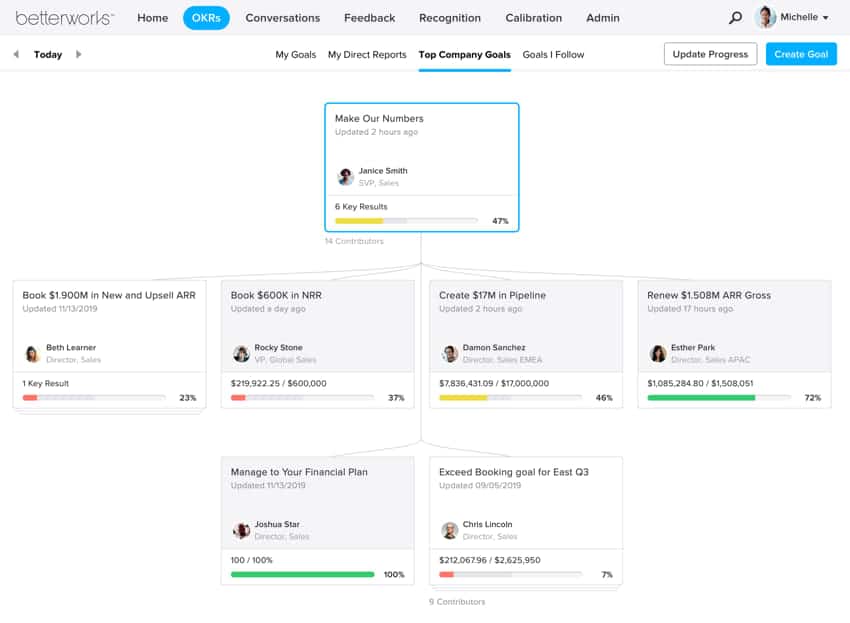Objectives and Key Results (OKRs)

Ideas are easy.
It’s execution that’s everything.
John Doerr
Chair, Investor, and Board Member of Betterworks

OKRs stands for “Objectives and Key Results,” a collaborative goal-setting model used by organizations to achieve challenging, ambitious goals.
The benefits of this robust goal-setting framework include improved focus, increased transparency, and better alignment around top priorities. Objectives and key results help entire companies communicate company strategy to employees in an actionable, measurable way.
The intuitive model has been adopted across many industries and by organizations of all sizes. It has been particularly powerful at high-growth companies.
What Are OKRs (OKR Definition)?
OKRs include a meaningful, concrete, clearly defined goal and three to five key results that support that goal. When combined, objectives and key results enable organizations to close the loop on people, strategy, and results.
You can have organizational OKRs, team OKRs and individual OKRs. Some people even develop personal OKRs.
What Is an Objective?
An objective is what you want to accomplish. Objectives are usually aspirational goals that are tied to the company’s larger strategic priorities.
What Are Key Results?
The key results demonstrate how you’ll achieve your objective. Key results aren’t a task list. Key results are measures of the work, not the work itself.
Why Do OKRs Matter?
Objectives and Key Results (OKRs) are easy to track, and they empower leaders to share company strategy across the organization in an actionable way. Once employees understand the company’s priorities, they can collaborate with managers to set their own objectives that drive those priorities forward.
The framework requires a commitment to no more than two or three objectives per quarter. The process of deciding those priorities clarifies and refines a company’s strategy.
Implementing OKRs provides many benefits. With OKRs you can:
- Align your organization on strategic priorities. The framework empowers you to align on objectives from the boardroom to the front lines.
- Achieve aspirational objectives. You can set ambitious — but realistic — stretch goals and observe tangible progress toward them.
- Offer an intuitive framework for performance management. OKRs enable employees to collaborate with managers to set goals that drive the business forward. Employees gain a sense of purpose by taking ownership of their objectives, which positively impacts employee engagement.
- Focus on what matters most. Instead of working in different directions, OKRs empower the organization to commit to a few strategic priorities. The efforts of all team members are concentrated on achieving one to three goals.
- Track progress toward measurable goals. Progress updates provide tangible proof for everyone in the organization that progress is being made.
OKRs Resources
OKRs vs. KPIs: How They Differ
One crucial difference is that OKRs are a complete strategic framework for goal management. On the other hand, KPIs are part of a framework and are only useful for tracking progress. (SMART goals, in contrast, cover the objective but not the how.)
Another important difference between OKRs and KPIs is that OKRs move the needle on outcomes, while KPIs measure output. KPIs track the actions you need to take to make progress, but key results measure the outcomes of those actions. Because KPIs provide measures for performance, they can be converted to key results within the OKR framework.
Understanding OKRs vs. KPIs can help you decide which approach is best for your needs.
Who Created OKRs:
John Doerr and ‘Measure What Matters’

The modern OKR framework was pioneered by John Doerr, who learned the basic concept from Andy Grove during their shared time at Intel. Doerr created a simple formula:
I will ________ as measured by ________.
Distilling your company’s priorities into the goal formula helps you stay focused. It forces you to identify the direction you truly want to take, identify gaps, and take concrete action to close them.
In 2018, Doerr published “Measure What Matters,” outlining the framework and highlighting some of the big-name companies that have found success using it. The most famous early adopters were the Google team. They began using the framework in 1999 and still use it today.
Now a renowned venture capitalist, Doerr is a Betterworks investor and board member.
From our partners at Measure What Matters
OKR Examples and Templates
An OKR has four basic components:
- An owner. OKRs require clear accountability.
- A specific time frame. OKRs must be time-bound.
- Objectives. This is what you’re working toward.
- Key results. These allow you to measure progress toward objectives.
- Reduce rejected expense reports by 10%
- Hold All Hands meeting in Q1 dedicated to financial understanding
OKRs Lab

The Top 5 Mistakes Executives Make When Running an OKR Program

Five Questions Executives Should Ask When Launching OKRs
Getting Started with OKRs
- Start with a clear vision. Identify why you’re implementing an Objectives and key results framework. What do you hope to change?
- Be honest. The more open you are about your gaps, the more clearly your vision for the program will come into focus.
- Develop a governance structure. Identify who’s taking ownership of the program and what that will look like.
- Implement a steering committee and champions. Invite departmental representatives to sit in your steering committee and appoint champions on the ground to keep the program on track.
- Launch a pilot program. Because OKRs scale so easily, teams can test the model before rolling out to larger business units.
- Be gentle with yourself. Remember that it usually takes time to hit your stride. If you only reach 50% of your goal in the first run, that’s still progress.
Look for OKR tools and service solutions that can be tailored to meet your company’s unique needs. The software should provide visibility and transparency, and your vendor partner should be accessible, especially as you launch the program.
5 Common OKR Mistakes
- Using OKRs as a task list. OKRs provide a strategic framework. If you’re viewing your key results as a transactional task list, you’re missing opportunities to stay alert and pivot your strategy to meet evolving needs.
- Setting too many OKRs. Working toward too many goals dilutes your efforts. Set one to three aspirational, but realistic, OKRs per quarter.
- Not aligning your OKRs. OKR goals won’t provide any benefits if they’re set in silos. Start with organizational priorities, then have department heads, team leads, and individual contributors set OKRs to move those priorities forward.
- Lacking support for organizational change. Switching to an OKR framework requires a mindset shift. Provide change management and other support to align and guide your company through the transition.
- Failing to review and update your goals regularly. OKRs are designed to be revisited as circumstances and priorities evolve. Plan on setting manageable quarterly objectives.
By aligning the company from the boardroom to the front lines, you can leverage OKRs to close the loop on people, strategy, and results.
Learn more about using OKRs with Betterworks


